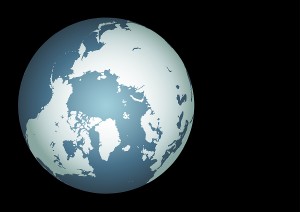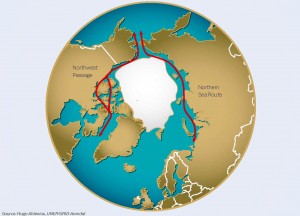2012-10-10 by Robbin Laird
A key element for the U.S. contribution to Pacific defense is the ability to provide strategic depth for our allies. Projecting power forward is a key contribution to enhancing the ability of allies to defend themselves, and to shape an interoperable Pacific defense strategy. Along with Canada, the United States provides a core physical capability: strategic depth.
For the United States, much of this revolves around the contribution of Alaska.
As Lt. Gen. (retired) Charles R. Heflebower, a former 7th USAF Commander, put it in a recent interview:
The ability to surge in force is crucial. When I was there (in South Korea), I calculated that if we could remain viable through the first 20 days of combat, forces could be surged to the area and turn the tide.
In this sense, Alaska is a crucial asset to any American Pacific strategy.
People don’t realize how strategic Alaska is until you really look at a map and recognize its central role in terms of getting forces into the region.
Alaska is the home of the 11th USAF, which is headquartered at Elmendorf Air Force Base, Alaska. It is at this base that the joint exercise Northern Edge is held every two years, to provide for the kind of joint and coalition operation that would be necessary to surge force.

A key coalition exercise to provide for some of the same capability is Red Flag, which is held in part at Eielson Air Force Base in Anchorage Alaska. The base was a front line base until 2007 and now primarily operates to support Red Flag. This kind of downgrading decision might well have to be re-thought as the U.S. shapes a 21st century Pacific strategy.
And under the Command of Northcom, the 49th Missile Defense Battalion operates the Ground Based Missile Defense Command at Fort Greely, Alaska. The operational control and execution is provided by the US Army, and is in part an answer to one of the contributions, which the Army makes to a Pacific strategy.
But the GBMD faces an uncertain future but the need is clear, notably if Alaska is to play its crucial role in providing strategic depth for a surge of forces in case of need. Such defense is a key element of the kind of 21st century attack and defense enterprise necessary for the projection of power in the Pacific.
Alaska would be important simply as a key foundation for providing strategic depth for U.S. and allied forces in the Pacific. And the relationship with Canada is also crucial in this regard.
In an interview with a senior Danish Ministry of Defence official (Admiral Nils Wang, Commandant of the Royal Danish Defence College and former head of the Danish Navy) the role of Canada in the Arctic was highlighted:
The Admiral saw the Canadians has pursuing a wide-ranging strategy. They are buying frigates as part of the strategy. And there is concern with future use by among others the Chinese in operating SSBNs in the Arctic waterways. They were clearly trying to build capabilities to deal with maritime safety and security, and presence, and various ways to protect their sovereignty.
The Canadians were not interested in making NATO the manager of the strategy; they are seeking to shape a national strategy to protect their waterways and resources.
The importance of Alaska for the United States will go up dramatically over time as the Arctic and its resources become ever more within reach. It is difficult to underestimate the impact of the resources in the Arctic on the global community, and notably upon the Arctic 5. The 5 members of the Arctic Council – the Kingdom of Denmark, Norway, Canada, Russia and the US currently control in principle 80% of known Arctic resources in the 200-mile EEZs or Exclusive Economic Zones.
The U.S. is the least active or focused member of the group. It is at best a “reluctant” Arctic power. This reluctance needs to end, and resources and commitments made to build out U.S. presence and leadership in the region.
The Russians are clearly the most active in the region, and the Arctic forms a key element of Putin’s energy strategy.
As Richard Weitz has argued:
In the current situation, the Russians and Canadians are committing resources ahead of the other three. Denmark and Norway are next and the US is dead last in committing resources to the Arctic mission.
Not only are there political challenges to gaining access to Arctic fuel reserves, but the geography of the region must also be taken into account. These reserves lack functioning gas fields and pipelines, and require hundreds of billions of dollars in investments. Even then, many of these areas may not be accessible until the ice cap shrinks further. Russia has responded to these challenges by announcing a number of costly programs to explore and develop East Siberian oil and gas fields and to build a network of oil and gas pipelines towards the 2020-2030 time frame, despite their costing many tens of billions of dollars.
The Kremlin appears to see the Arctic as a necessary part of Russia’s future security in the realms of energy and geopolitics. Putin has advocated the aggressive expansion of the Arctic, citing the “urgent” need to secure Russian “strategic, economic, scientific and defense interests” there.
The low priority the United States pays to the Arctic is best symbolized by the non-commitment to building a new icebreaker.
As Rear Admiral Jeffrey M. Garrett, U.S. Coast Guard (Retired) and one of the nation’s leading experts on the Arctic has underscored:
The Icebreaker fleet represents the main surface presence that the U.S. can exert in what is essentially a maritime domain in the Arctic Ocean. An area that is becoming much more accessible to a whole range of human activities. And it’s clearly brought Arctic Alaska, the U.S. piece of the Arctic into a new concern for the Coast Guard, particularly in terms of exercising its statutory responsibilities there. It is obviously important as well for protecting broader national interests, such as presence, sovereignty, and even support of defense operations.
The Icebreaker is really the platform that can give you year-round access to that for both the broader national interest, as well as being able to conduct Coast
The Icebreakers are clearly very expensive ships compared to others. But really, the perspective should be what is the cost of not having an Icebreaker? If you have a major contingency in the Arctic, whether it’s security related, oil spill related, or something like that, even search-and-rescue, or tourism ships getting in trouble, you have no way of responding. And the cost of not being able to respond to those things may be very high.
The Icebreaker is an insurance policy against future contingencies in a rapidly transforming Arctic.
And to put this in perspective, the U.S. currently only has one operational icebreaker, a medium icebreaker called the USCGC Healy. The ship was built in 1996.
But it is not just about icebreakers. You cannot have a Pacific strategy if you do not manage the challenges reaching from the Arctic to Australia. If the US intends to have a 21st century Pacific strategy, it needs to start with Arctic presence and commitment.
We have policy papers, studies and presentations. What we don’t have is a credible roll out of capability.
Strategy without capability or a plan for crafting capability is vaporware. The Arctic is clearly an area in which presence assets, both surface and airborne, need to be networked to provide for maritime safety, security and search and rescue capabilities.
The other members of the Arctic Council are not waiting around for U.S. leadership. Perhaps this is another case of leading from behind.
According to a Wall Street Journal story:
Russia plans to deploy two army brigades in the north to defend its interests in the Arctic regions, where governments citing climate change have made competing claims over natural resources.
Russia’s defense minister said officials haven’t yet worked out the details of troops or weaponry, but that the brigades, which usually number a few thousand troops, would be cobbled together with an eye toward the experience of Russia’s northern neighbors—Finland, Norway and Sweden—which already have such northern forces.
“The location will be determined, as well as weapons, numbers and infrastructure for the brigades,” said Defense Minister Anatoly Serdyukov, according to Russian news agencies. “They could be put in Murmansk, Arkhangelsk or another place.”
The need is clear; and a solid multinational approach would allow the U.S. to build out capabilities with the others in shaping an effective Arctic strategy.
The Russians understand that an Arctic strategy is at the same time a European and a Pacific strategy. And the new trade routes, which will emerge over time, will validate their approach and understanding
http://uk.nanoq.gl/~/media/29cf0c2543b344ed901646a228c5bee8.ashx
The other four members of the Arctic Council – Canada, Norway, Denmark and the United States – are all members of NATO and have more in common than divides them. The wealth in the region will allow Canada, Norway and Denmark to shape a procurement strategy to populate their strategy.
At the heart of procurement is the need to build an Arctic capability, which can provide for maritime safety and security and search and rescue in difficult situations. Also required is an ability to protect themselves from new threats introduced into the region such as foreign SSBNs using the water transit routes.
The 4 need air and naval assets which can operate 24/7, 365 days to deal with presence, sovereignty and safety issues. By meeting twice a year, or before any meeting of the Arctic Council, the four countries could build collaborative and convergent capabilities. There would be no compelling need to have explicit collaborative programs, but as nation’s buy the proper helicopters, maritime patrol aircraft, ISR aircraft, and ships, there is a clear opportunity to leverage one anothers buys of equipment.
By shaping a 10-year plan for convergent procurement, common concepts of operations could be shaped by the 4 NATO partners without the explicit need to include NATO. The process would be very transparent and can be briefed to Russia as part of the Arctic Council process.
In short, financial assets are there to build capability. And the West needs to find ways to protect its interests in the decade ahead and not only in the Arctic.
An earlier version of this piece appeared on AOL Defense.


